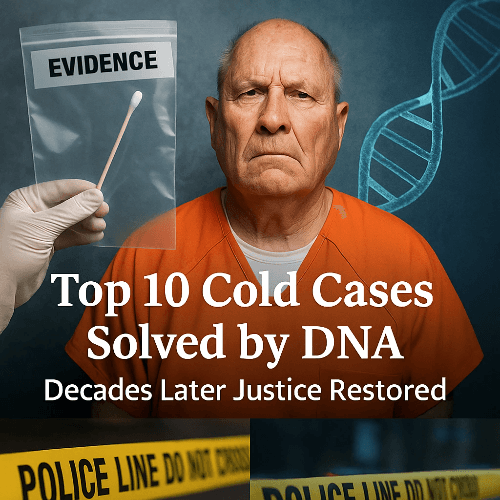
These Top 10 Cold Cases Solved by DNA showcase how forensic science and genetic genealogy have transformed justice. From deeply buried evidence to family tree matching, technology gives a voice to victims and closure to families—even decades later
1. The Golden State Killer – Joseph DeAngelo (1974–86)
One of the most notorious cases ever solved with DNA was that of the Golden State Killer, Joseph James DeAngelo. His crimes spanned California from the mid 1970s through the 1980s. In 2018, investigators used genetic genealogy—combining crime scene DNA with public ancestry databases—to trace familial links and eventually match DeAngelo via discarded items like napkins or a razor. He was arrested and tied to 13 murders, over 50 rapes, and numerous burglaries.
📚 The New York Times – How the Golden State Killer Was Caught

2. Murder of Anna Jean Kane (1988, Pennsylvania)
Pennsylvania's cold case of Anna Jean Kane, brutally killed in 1988, remained unsolved for decades. Using advanced DNA genetic genealogy in 2022, investigators identified Scott Grim as the killer. Authorities linked DNA evidence from the crime to relatives in public databases, leading to his arrest and resolving a mystery over 30 years old.
________________________________________
3. Nancy Marie Bennallack (1970, Sacramento)
Nancy Bennallack, a 28 year old court reporter stabbed to death in 1970, had no answers for over 50 years. In 2022, forensic genealogy pinpointed Richard John Davis as her killer. Though deceased by then, DNA from family members in public databases confirmed his involvement, bringing closure after half a century.
________________________________________
4. Babes in the Woods (1947, Vancouver)
Two young boys found murdered in Stanley Park, Vancouver, in 1947 remained unidentified until 2022. Through consumer DNA databases like Ancestry and 23andMe, genealogists traced the children to the D’Alton brothers. This case illustrates how DNA can not only identify perpetrators but also victims, even decades later.
________________________________________
5. Murder of Rita Curran (1971, Vermont)
Rita Curran was brutally killed in Burlington in 1971. Investigators later obtained semen profiles from the crime scene and, using genetic genealogy and family DNA matches, identified William DeRoos—once questioned back in 1971—as the killer. A relative's sample confirmed the match. The breakthrough came nearly five decades later.
📚 _NPR_ – DNA solves 50-year-old Vermont cold case
________________________________________
6. Mary Silvani – “Sheep’s Flat Jane Doe” (1982, Nevada)
Known as “Sheep’s Flat Jane Doe” for nearly 37 years, this unidentified body found near Lake Tahoe was finally identified in 2019 as Mary Edith Silvani. The DNA Doe Project used GEDmatch and genetic genealogy to match her to relatives. This also linked her murder to serial killer James Curry, who confessed before committing suicide.
________________________________________
7. Kathryn Donohue (1979, Maryland)
Kathryn Donohue, murdered in 1979, had remained unidentified for decades. In 2025, authorities used forensic genetic genealogy with DNA from a discarded fork. After nearly four years of family tree analysis and re testing, they arrested 82 year old Rodger Zodas Brown. The case’s resolution was hailed as a triumph of persistence and modern science.
________________________________________
8. Laura Kempton (1981, New Hampshire)
In 1981, 23 year old Laura Kempton was discovered dead in her Portsmouth apartment. Her murder remained unsolved for 40+ years until genetic genealogy finally broke through in 2023. Investigators were able to build her killer’s profile via distant relatives in public DNA databases, solving a case once thought cold forever.
________________________________________
9. Terri McAdams (1985, Texas)
Terri McAdams was raped and murdered on Valentine’s Day in Arlington, Texas. Despite early leads, no suspect was named. In 2024, the FBI and cold case detectives used genetic genealogy to identify Bernard Sharp, using DNA from relatives on genealogy sites like Ancestry.com. Sharp had died in 1985, but the identification gave the family long overdue closure.
________________________________________
10. Carl Matthew Bryant (1972, Virginia)
In a tragic case from 1972, a young boy found dead in Virginia was long known only as a charred and unidentifiable “John Doe.” In 2025, forensic genealogy specialists used hair fragments to build a DNA profile. That led to a match with a Philadelphia family, identifying the boy as Carl Matthew Bryant. Police named his likely killers and brought resolution to a decades old horror.
________________________________________
Frequently Asked Questions
Q1: What is genetic genealogy and how does it work in solving cold cases?
A1: Genetic genealogy combines crime scene DNA evidence with profiles in public genealogy databases. By finding distant relatives and building family trees, investigators can zero in on suspects even without a direct match.
Q2: Can DNA solve cases without reaching the alleged perpetrator directly?
A2: Yes—many cases use familial DNA matches to infer a suspect’s identity even when the suspect’s own DNA isn't in law enforcement databases.
Q3: Are there ethical or privacy concerns tied to genetic genealogy?
A3: Yes. Using public genealogy sites raises concerns over consent and potential misuse, prompting ongoing debate over law enforcement access and privacy rights (The Sun).
Q4: How old can a case be and still be solved using DNA?
A4: Cases from the 1940s, 1950s, even earlier have been solved—sometimes involving exhumed remains or tiny preserved samples of hair or biological evidence.
Q5: Does solving a cold case rely entirely on DNA?
A5: DNA often provides the breakthrough, but investigators still gather corroborating evidence, interviews, and context before making an arrest.
Q6: Who performs these DNA genealogy investigations?
A6: Specialized forensic labs, volunteer groups like the DNA Doe Project, and law enforcement agencies often collaborate for complex analyses and genealogical research.
If you enjoy forensic investigation crime stories, here's book one in my new series Flesh, Fire & Code now available on Amazon:

